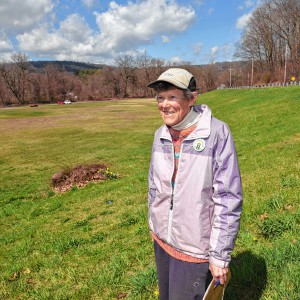Speaking of Nature: Great Plains nomad — The brown-headed cowbird
| Published: 03-19-2023 9:48 AM |
In the year 1500, just a blink of an eye before Europeans started migrating into North America in large numbers, the ecology of the “New World” was relatively stable. Forests of various types dominated the eastern third of the continent, forests of different types dominated the western coastal and mountain areas and in between was a progression of deserts and grasslands. Looking at the different habitats is a basic starting point for any student who wishes to understand how latitude, topography and wind patters influence weather, climate and ecosystems.
With a predominantly westerly wind pattern, the West Coast was bound to be wet and lushly forested. A convergent boundary of tectonic plates produced mountains and this topographic feature was going to ensure that the areas to the west of those mountains would see lots of rain and snow. As the wet air is pushed up and over the mountains the water is squeezed out of the atmosphere, which means that cold, dry air will descend on the eastern side of the mountains resulting in deserts.
Deserts gradually gave way to grasslands as the air moved eastward and the influence of coastal wind patterns from the Gulf of Mexico brought moisture inland. Eventually, the combined influences of the Atlantic Coast and the Gulf Coast provided enough water to support forests once again. This, in a nutshell, is how the Great Plains came to be. A huge area in the center of a huge continent that would happily have been forest, but there just wasn’t enough reliable rainfall to support trees. So, it was grass that became the dominant plant species and grass determined the types of animals that would live there.
Perhaps the most famous of the grassland animal to inhabit the Great Plains is the American bison. A huge ungulate (males can weigh over 2,000 pounds), this animal was famous for being a seasonal migrant much like some of the great grazing animals of Africa. With an initial population of about 60 million individuals, bison had an enormous impact on the grasslands and they themselves became a resource for other animals, including predators and a host of other species that depended on them. One of these dependents was the brown-headed cowbird (Molothrusater).
This species of “blackbird” found everything it wanted in the presence of bison. The issue to remember is that grazing animals that gather in such huge numbers have to move around so they don’t run out of food. This meant that the great herds were never in the same place for very long, making it a challenge for nesting birds to set up shop long enough to reproduce. So the cowbird evolved a clever solution to this problem — they never set up shop at all.
Instead, cowbirds became what ornithologists call an “obligate brood parasite.” In layman’s terms, they rely on other species to raise their offspring. Males are not particularly territorial because there was no need for it. The males compete for the attention of females and the females are always on the lookout for small birds that are building nests where they can surreptitiously lay their own eggs. They don’t immediately abandon their eggs, but eventually they move on and rely on other species to raise their offspring.
This species probably should have been called a brown-headed bisonbird, but those European migrants had some major impacts on the wildlife of the New World. In 1776 there were 60 million bison. By 1889 only 541 individuals remained. The Europeans, the future Americans, replaced the bison with domestic cattle (cows) and the cowbirds happily accepted the substitutes. In fact, the clearing of the eastern forests actually helped the cowbirds to expand their range to the east.
But, as with all major changes, there were some problems. The birds of the east had never seen a cowbird before and had no experience with defending themselves from being parasitized. Many were vulnerable to the cowbirds and to this day there is one species, the Kirtland’s warbler, that only survives because of intensive human efforts to control brown-headed cowbird parasitism.
Article continues after...
Yesterday's Most Read Articles
 Greenfield man arrested in New York on murder charge
Greenfield man arrested in New York on murder charge
 Former Leyden police chief Daniel Galvis charged with larceny
Former Leyden police chief Daniel Galvis charged with larceny
 Judge dismisses case against former Buckland police chief
Judge dismisses case against former Buckland police chief
 Greenfield Police Logs: April 9 to April 17, 2024
Greenfield Police Logs: April 9 to April 17, 2024
 Millers Meadow idea would ‘completely transform’ Colrain Street lot in Greenfield
Millers Meadow idea would ‘completely transform’ Colrain Street lot in Greenfield
 Greenfield’s Court Square to remain open year-round for first time since 2021
Greenfield’s Court Square to remain open year-round for first time since 2021
Spring begins today and the brown-headed cowbirds have arrived in preparation for the breeding season. As you and I enjoy the songs and breeding displays of the local birds, the female cowbirds are looking at them with a much more calculating eye. They pay very close attention to who is breeding and where the nests are so that they can take advantage of the situation and quickly swap one of their own eggs for one of their victims’. I know the proper term is “host,” but the word victim tells a better story.
Male brown-headed cowbirds are covered with glossy black feathers, but their heads are the color of milk chocolate. Female cowbirds are gray in color, but they are the same exact size and shape as the males and they are rarely seen alone. Where a female goes there is bound to be a male right behind her. Keep your eyes open for these birds at your feeders in the next month. They are willing to come fairly close to people since we have been so beneficial for them.
Bill Danielson has been a professional writer and nature photographer for 25 years. He has worked for the National Park Service, the U.S. Forest Service, the Nature Conservancy and the Massachusetts State Parks and he currently teaches high school biology and physics. For more in formation visit his website at www.speakingofnature.com, or head over to Speaking of Nature on Facebook.
]]>

 Speaking of Nature: Indulging in eye candy: Finally, after such a long wait, it’s beginning to look like spring is here
Speaking of Nature: Indulging in eye candy: Finally, after such a long wait, it’s beginning to look like spring is here Celebrating ‘Seasonings’: New book by veteran preacher and poet, Allen ‘Mick’ Comstock
Celebrating ‘Seasonings’: New book by veteran preacher and poet, Allen ‘Mick’ Comstock Faith Matters: How to still the muddy waters of overthinking: Clarity, peace and God can be found in the quiet spaces
Faith Matters: How to still the muddy waters of overthinking: Clarity, peace and God can be found in the quiet spaces A time for every purpose under heaven: Free sing-a-long Pete Seeger Fest returns to Ashfield, April 6
A time for every purpose under heaven: Free sing-a-long Pete Seeger Fest returns to Ashfield, April 6
